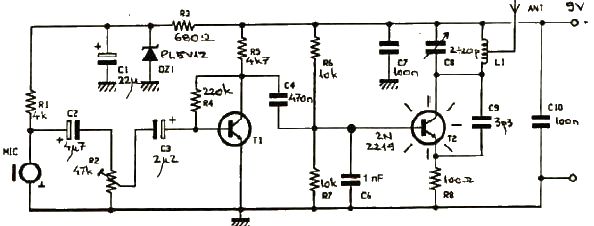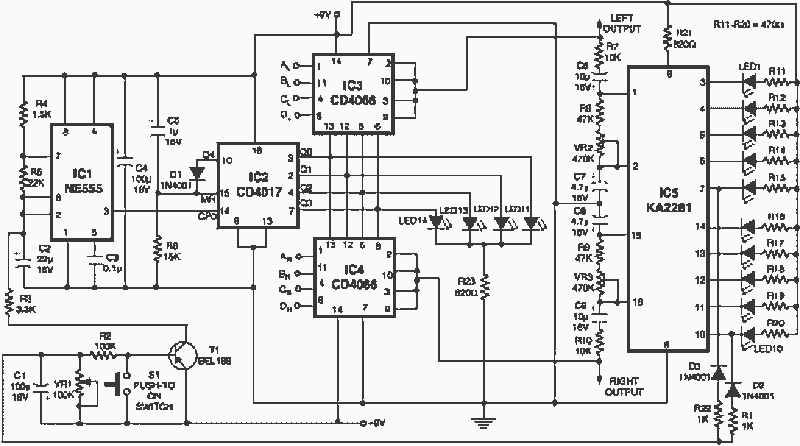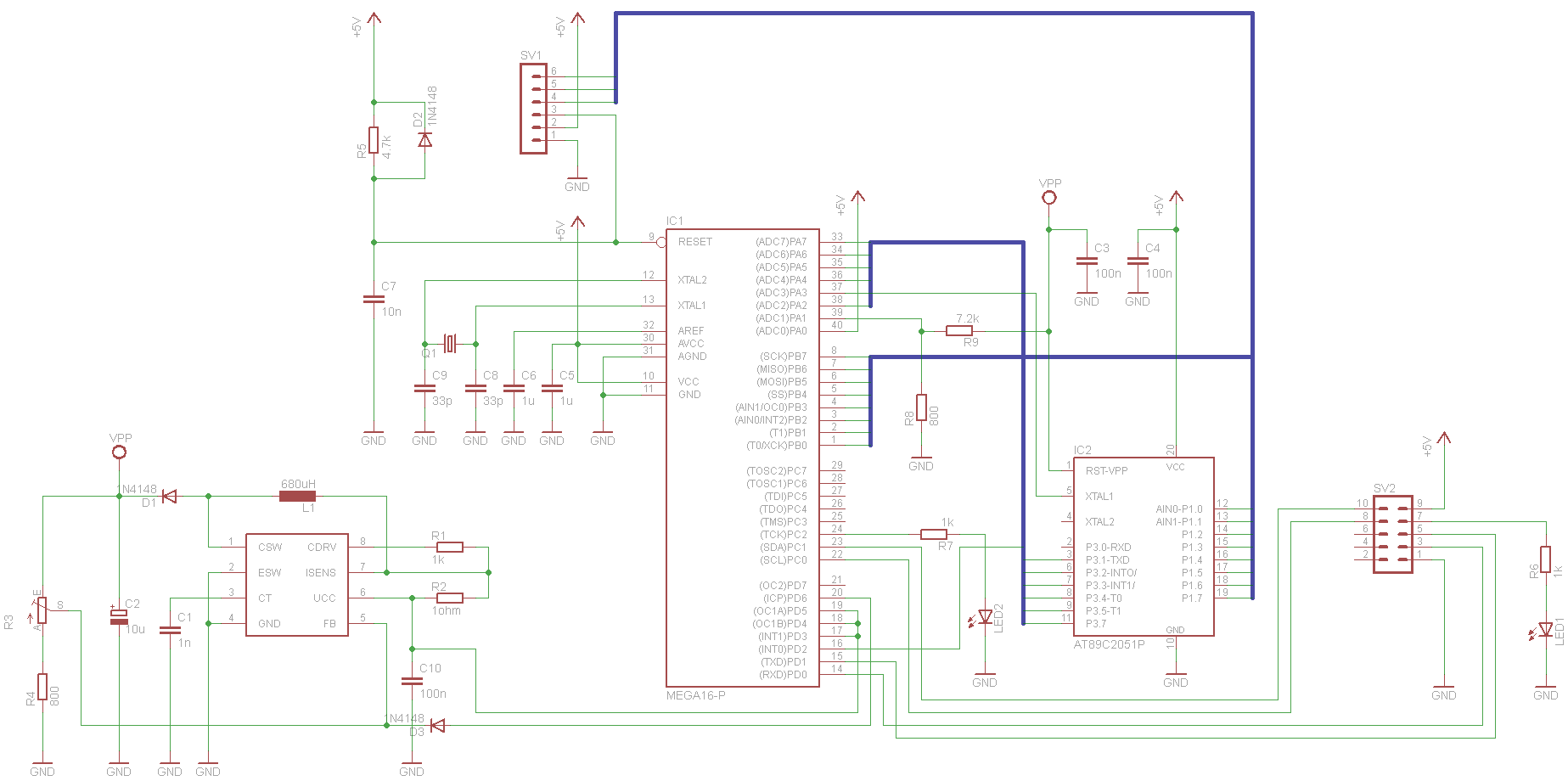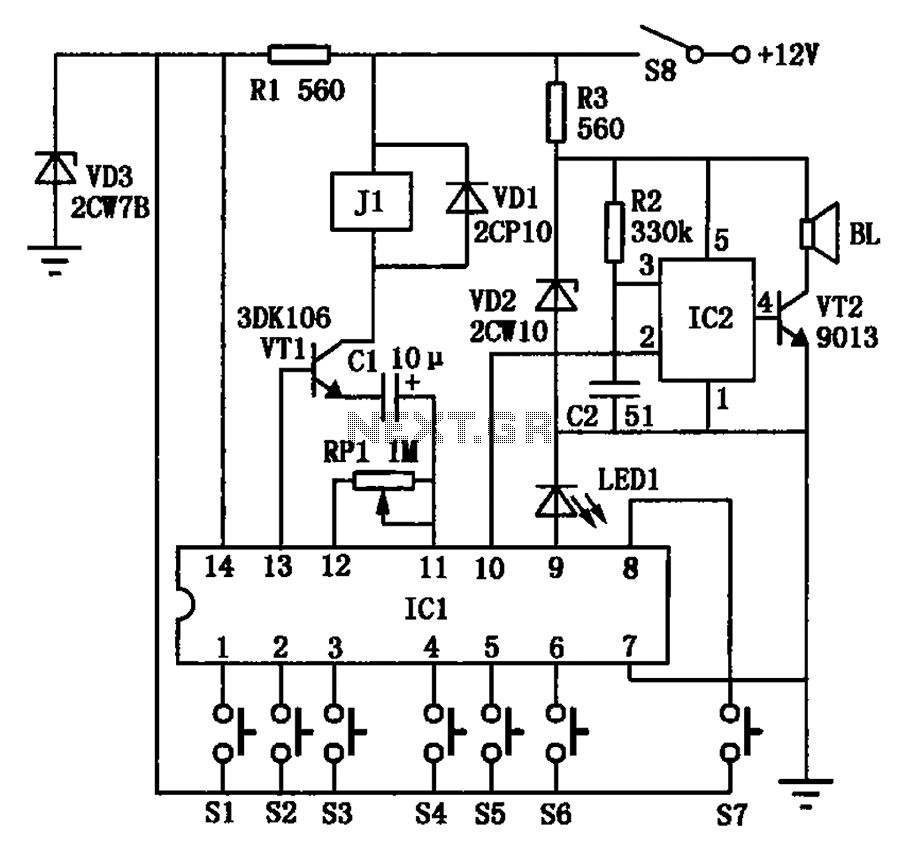
Incandescent Yeonsu electronic controller 3
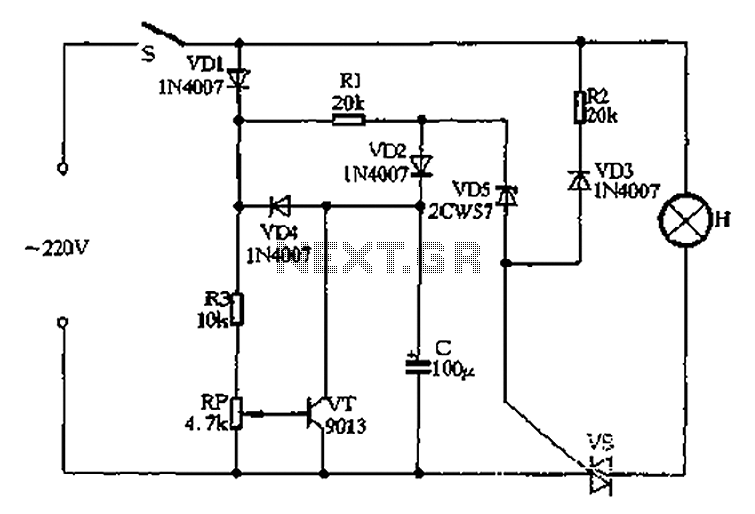
Closing switch S allows the power supply's positive half cycle to flow through VD1, R1, and VD2 to charge capacitor C. The voltage across capacitor C gradually increases but remains significantly lower than the threshold voltage of the zener diode VD5, which remains in the off state. As a result, there is no current flowing through the bulb H during this phase. During the negative half-cycle of the alternating current, current flows through R2 and VD3 to provide a negative trigger current to SCR VS, turning it on and allowing the half-wave alternating current to preheat the lamp H. As long as the voltage across capacitor C is below the regulation value of VD5 during the alternating cycle, the current flowing through lamp H is limited to a half-cycle, initiating a soft-start process for the lamp. Over time, as the voltage across capacitor C rises and exceeds the regulation value of VD5, VD5 turns on and provides a pull-up current to SCR VS, allowing it to conduct during the positive half cycle as well. Once the soft-start process concludes, the bulb H operates at full voltage from the power supply. The duration of the soft start is primarily determined by the capacitance of capacitor C.
The circuit described operates as a soft-start mechanism for a lamp using a combination of diodes, resistors, a capacitor, and an SCR. The switch S, when closed, initiates the charging of capacitor C through diodes VD1 and VD2, with resistor R1 limiting the charging current. The gradual increase in voltage across capacitor C is crucial for controlling the operation of the zener diode VD5, which regulates the voltage and ensures that the SCR VS remains off during the initial charging phase.
During the negative half-cycle of the AC input, the current through resistor R2 and diode VD3 provides the necessary negative trigger current to SCR VS, allowing it to turn on. This initiates the preheating of the lamp H, allowing it to slowly ramp up its brightness. The soft-start feature is essential for preventing inrush current that could damage the lamp or the circuit components.
As the voltage across capacitor C continues to rise and eventually exceeds the zener breakdown voltage of VD5, the zener diode conducts, allowing current to flow to SCR VS, which turns it on fully. This transition marks the end of the soft-start process and allows the lamp H to receive full voltage, resulting in normal operation. The time constant of the soft-start process is determined by the capacitance value of capacitor C and the resistance values in the charging path, which can be adjusted to modify the soft-start duration according to the application requirements.
In summary, this circuit effectively manages the startup of a lamp by controlling the voltage applied to it through a carefully designed sequence of charging, triggering, and regulation, ensuring a smooth transition to full brightness while protecting the components involved. Closing switch S, the power supply positive half cycle, the power by VD1, Rl, VD2 to charge the capacitor C, C at both ends of the electrical pressure gradually increased, but much lower than the threshold voltage of the zener diode of VD5, VD5 in the off state, can silicon vs control because there is no contact Friends of the current in the off state, then no current flows through the bulb H. When the negative half-cycle alternating current, the current through R2 and VD3 to provide SCR vs negative trigger current, vs opened, there was a half-wave alternating lamp H by preheating.
As long as the voltage across capacitor C is less than the regulation value VD5 in an alternating cycle, the current flowing through the lamp H is only half week period, which is the soft-start process of the lamp. Over time, C voltage across the rising, when raised to well over VD5 when regulation value, VD5 conduction, and provide contact pull-up current SCR vs, so in alternating positive half weeks, vs also opened pass, when the soft-start process ends bulb, the bulb H enters full voltage power supply status.
Soft start time mainly by the capacitance C of the decision capacitance.
The circuit described operates as a soft-start mechanism for a lamp using a combination of diodes, resistors, a capacitor, and an SCR. The switch S, when closed, initiates the charging of capacitor C through diodes VD1 and VD2, with resistor R1 limiting the charging current. The gradual increase in voltage across capacitor C is crucial for controlling the operation of the zener diode VD5, which regulates the voltage and ensures that the SCR VS remains off during the initial charging phase.
During the negative half-cycle of the AC input, the current through resistor R2 and diode VD3 provides the necessary negative trigger current to SCR VS, allowing it to turn on. This initiates the preheating of the lamp H, allowing it to slowly ramp up its brightness. The soft-start feature is essential for preventing inrush current that could damage the lamp or the circuit components.
As the voltage across capacitor C continues to rise and eventually exceeds the zener breakdown voltage of VD5, the zener diode conducts, allowing current to flow to SCR VS, which turns it on fully. This transition marks the end of the soft-start process and allows the lamp H to receive full voltage, resulting in normal operation. The time constant of the soft-start process is determined by the capacitance value of capacitor C and the resistance values in the charging path, which can be adjusted to modify the soft-start duration according to the application requirements.
In summary, this circuit effectively manages the startup of a lamp by controlling the voltage applied to it through a carefully designed sequence of charging, triggering, and regulation, ensuring a smooth transition to full brightness while protecting the components involved. Closing switch S, the power supply positive half cycle, the power by VD1, Rl, VD2 to charge the capacitor C, C at both ends of the electrical pressure gradually increased, but much lower than the threshold voltage of the zener diode of VD5, VD5 in the off state, can silicon vs control because there is no contact Friends of the current in the off state, then no current flows through the bulb H. When the negative half-cycle alternating current, the current through R2 and VD3 to provide SCR vs negative trigger current, vs opened, there was a half-wave alternating lamp H by preheating.
As long as the voltage across capacitor C is less than the regulation value VD5 in an alternating cycle, the current flowing through the lamp H is only half week period, which is the soft-start process of the lamp. Over time, C voltage across the rising, when raised to well over VD5 when regulation value, VD5 conduction, and provide contact pull-up current SCR vs, so in alternating positive half weeks, vs also opened pass, when the soft-start process ends bulb, the bulb H enters full voltage power supply status.
Soft start time mainly by the capacitance C of the decision capacitance.
